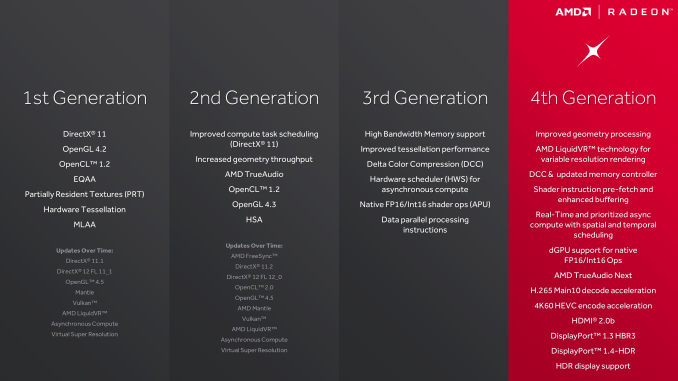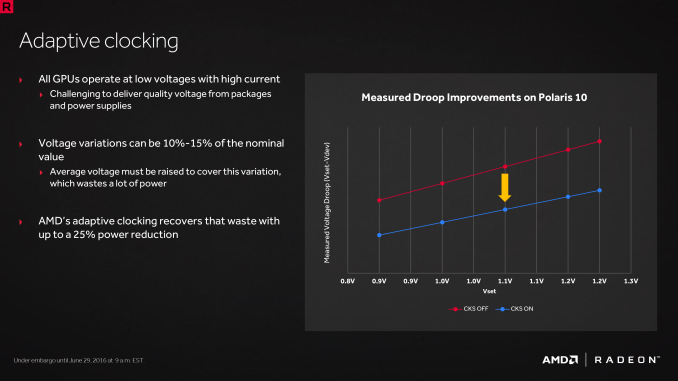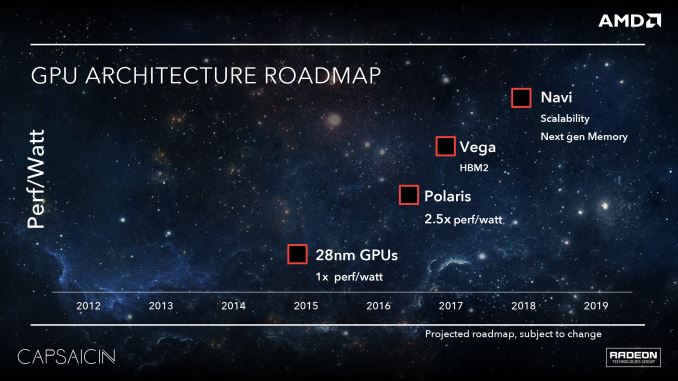The AMD Radeon RX 480 Preview: Polaris Makes Its Mainstream Mark
by Ryan Smith on June 29, 2016 9:00 AM ESTAMD's Path to Polaris
With the benefit of hindsight, I think in reflection that the 28nm generation started out better for AMD than it ended. The first Graphics Core Next card, Radeon HD 7970, had the advantage of launching more than a quarter before NVIDIA’s competing Kepler cards. And while AMD trailed in power efficiency from the start, at least for a time there they could compete for the top spot in the market with products such as the Radeon HD 7970 GHz Edition, before NVIDIA rolled out their largest Kepler GPUs.
However I think where things really went off of the rails for AMD was mid-cycle, in 2014, when NVIDIA unveiled the Maxwell architecture. Kepler was good, but Maxwell was great; NVIDIA further improved their architectural and energy efficiency (at times immensely so), and this put AMD on the back foot for the rest of the generation. AMD had performant parts from the bottom R7 360 right up to the top Fury X, but they were never in a position to catch Maxwell’s efficiency, a quality that proved to resonate with both reviewers and gamers.
The lessons of the 28nm generation were not lost on AMD. Graphics Core Next was a solid architecture and opened the door to AMD in a number of ways, but the Radeon brand does not exist in a vacuum, and it needs to compete with the more successful NVIDIA. At the same time AMD is nothing if not scrappy, and they can surprise us when we least expect it. But sometimes the only way to learn is the hard way, and for AMD I think the latter half of the 28nm generation was for the Radeon Technologies Group learning the hard way.
So what lessons did AMD learn for Polaris? First and foremost, power efficiency matters. It matters quite a lot in fact. Every vendor – be it AMD, Intel, or NVIDIA – will play up their strongest attributes. But power efficiency caught on with consumers, more so than any other “feature” in the 28nm generation. Though its importance in the desktop market is forum argument fodder to this day, power efficiency and overall performance are two sides of the same coin. There are practical limits for how much power can be dissipated in different card form factors, so the greater the efficiency, the greater the performance at a specific form factor. This aspect is even more important in the notebook space, where GPUs are at the mercy of limited cooling and there is a hard ceiling on heat dissipation.
As a result a significant amount of the work that has gone into Polaris has been into improving power efficiency. To be blunt, AMD has to be able to better compete with NVIDIA here, but AMD’s position is more nuanced than simply beating NVIDIA. AMD largely missed the boat on notebooks in the last generation, and they don’t want to repeat their mistakes. At the same time, starting now with an energy efficient architecture means that when they scale up and scale out with bigger and faster chips, they have a solid base to work from, and ultimately, more chances to achieve better performance.
The other lesson AMD learned for Polaris is that market share matters. This is not an end-user problem – AMD’s market share doesn’t change the performance or value of their cards – but we can’t talk about what led to Polaris without addressing it. AMD’s share of the consumer GPU market is about as low as it ever has been; this translates not only into weaker sales, but it undermines AMD’s position as a whole. Consumers are more likely to buy what’s safe, and OEMs aren’t much different, never mind the psychological aspects of the bandwagon effect.
Consequently, with Polaris AMD made the decision to start with the mainstream market and then work up from there, a significant departure from the traditional top-down GPU rollouts. This means developing chips like Polaris 10 and 11 first, targeting mainstream desktops and laptops, and letting the larger enthusiast class GPUs follow. The potential payoff for AMD here is that this is the opposite of what NVIDIA has done, and that means AMD gets to go after the high volume mainstream market first while NVIDIA builds down. Should everything go according to plan, then this gives AMD the opportunity to grow out their market share, and ultimately shore up their business.
As we dive into Polaris, its abilities, and its performance, it’s these two lessons we’ll see crop up time and time again, as these were some of the guiding lessons in Polaris’s design. AMD has taken the lessons of the 28nm generation to heart and have crafted a plan to move forward with the FinFET generation, charting a different, and hopefully more successful path.
Though with this talk of energy efficiency and mainstream GPUs, let’s be clear here: this isn’t AMD’s small die strategy reborn. AMD has already announced their Vega architecture, which will follow up on the work done by Polaris. Though not explicitly stated by AMD, it has been strongly hinted at that these are the higher performance chips that in past generations we’d see AMD launch with first, offering performance features such as HBM2. AMD will have to live with the fact that for the near future they have no shot at the performance crown – and the halo effect that comes with it – but with any luck, it will put AMD in a better position to strike at the high-end market once Vega’s time does come.













449 Comments
View All Comments
D1v1n3D - Friday, July 1, 2016 - link
I think it is funny did all these Nvidia people forget what 970 landed on cost wise and then the limped along 3.5gb ram. AMD has many more models to come for instance the GDDR5X models and the hbm2 models AMD is just bringing in cash flow off a very capable mid-range card i will be buying one for my mini itx that currently is running 1gb 6950hd talk about an upgrade and at such an amazing value and allowing me to not stress my 450w PSU you guys and your unrealistic crossfire the latency alone would drive me up the wall to much fluctuation from so many sources gpu x 2 and cpu. maybe when it's two hbm2 cards crossed maybe the latency will be nonexistent.currently waiting for fm2+ refresh I sure hope they have one more before fm3/+ boards come out.
monohouse - Sunday, July 3, 2016 - link
it's a prayr-view, pray for AMD !monohouse - Sunday, July 3, 2016 - link
"Wise gamers" ? is such a thing even exists ?, do you know I play Doom 2 on a GTX 780 Ti ? so what ? more graphic resources are never a bad thing, I also play many DX9 games on windows XP so what ? a technologically fast video card benefits not only the bloat-filled spyware-infested windows 10, it's also good for accelerating old software (that is, if you can make it work / are given drivers to make it work)monohouse - Sunday, July 3, 2016 - link
but now that you mention smart gamers ? this is how I see it: there are 2 types of gamers:the first type are the ones that don't know what they are going to run on the system, their load is variable and they jump from one game to another, never knowing which game they will run next because they wait it's release
and the second are the ones that do know what they will run ahead of time and will not run anything but what they know
I classify them as static and dynamic types of gamers, so the RX 480 is it good or not good ? the question in my opinion is more complex than it seems, because I believe that there is more to video cards than just performance watts heat noise and price, you have to look at the bigger picture, at things like OpenCL (and you know that AMD are pretty good at that), at things like hardware quality (how precise is the graphic calculation) (which is also a department where AMD is better (usually, excluding the brilinear filtering of the 9600XT) and also have to look at image quality produced by the card(s), also look into stuttering (if there is any, and how much) all these aspects are just hardware related, but hardware does not exist on it's own, it exists together with driver, so not less important than looking at hardware quality is also software quality (a department which is usually pretty bad with AMD) how stable is the driver ? is there any BSOD ? is there any rendering bugs ? and of corse the performance of the driver.
how does this relate to type of gamers ? consider it: you know what you are going to run in the card, it could be a OpenCL program or some very specific games - then all you need is to find out how the card (with it's driver) is handling this specific load - and based on that decide if you want to buy/use it
but for the dynamic gamer this is much more complex because there is no way to predict what the software/load is going to be, so the decision is more difficult whether or not to buy, so here is my way:
static gamer buy what suits your load, if RX 480 can run your OpenCL/games well enough, stable and fast enough looking good then you have no problem to buy it
but for dynamic gamer I have to disagree on all the posts mentioned here, and all the estimationing cliche "1080p gaming", there is no line you can draw and all games having an equal load at a given resolution, there is no such thing as "this card will last me 2 years at 1080p", for the dynamic gamer this strategy is flawed, because nobody knows the future (that being said, console generations do have an impact because modern games are console games) and in addition some games are pre-built for a specific FPS target, and game engines are differently designed. so for the dynamic gamer I would not recommend RX 480, because it's performance already struggles with games that exist in the present, so for the dynamic gamer the best bet is the highest performing card (only under the condition that it runs every already released game at higher than the required FPS for you)
K_Space - Saturday, July 9, 2016 - link
Apologies for reading your comment so late, however it is was not posted under the parent thread:1) why wouldn't wise gamers exists? :) "the gamer self" does not exist in vacuum, a wise human who plays games is a wise gamer.
2) your analysis of the static vs dynamic gamer is really well put, though your use cases are broader, so user is more apt than gamer (and really fit with the gamer does not exist in a vaccum statement earlier). You have put plenty of caveats that we almost essentially agree: whilst no one can predict the future precisely, one can certainly develop some foresight by looking at trends/as well as typical use scenarios to predict future use cases. It's what IT departments do all the time anyway, "wise" gamers are no different :) Just as you'd predict after DX11 was released that most if not all AAA games will feature the buzz word tessellation, you would rightly predict that with the current gen of consoles future AAA games will be more VRAM heavy than current ones. multi core CPUs will be utalised more than they would in current DX11 games, etc. Ditto with the 1080p statement, if im planning a future GFX purchase I'd factor in if I'm considering to stick to native 1080p display or a denser display and act accordingly. By your definition a dynamic gamer does not know what their future games will demand, but their interests are typically static even if the games change; thus if hypothetically speaking i likes MOBA or indie games I'd hazard a good guess that a 480 and not a 1070 card is what I need for future indie/MOBA games. Remember, these "predictions" don't need to be pin point accurate, just something that will get me to my next upgrade cycle.
3) RTG has been quite spectular with their driver support releases. previous GCN cards have been reaping these benefits to this day. I've the additional benefit of retroscopy in considering how they promptly dealt with the 480 powergate fiasco.
dmark07 - Sunday, July 3, 2016 - link
I'm a little confused as to when benchmarks were performed for the NVIDIA 1070FE card. The only articles on Anandtech for this generation of NVIDIA cards only has benchmarks for the 1080. I wish your team would have written an article about the 1070 first before adding numbers for them to this article. As it appears, this either indicates someone used the 1080 numbers and labeled them as 1070FE or this was a biased move with unpublished numbers that could have been pulled out of thin air... This is very uncharacteristic of Anandtech. Don't get me wrong, I've been looking forward to a full breakdown of the 1070 but the Anandtech team use to stick to the standard of performing a write up on a card prior to using benchmarks for that card in comparisons.Ranger1065 - Tuesday, July 5, 2016 - link
Speaking as someone who has happily visited this site for many years, it's clear the Anandtech "team" is not what it used to be. I'm tired of visiting here only to NOT find the reviews I'm interested in and so I visit Anandtech less and less frequently. It's a shame because I know the staff are capable of writing really good reviews but my patience and faith in Anandtech is just about exhausted. Other sites may not have the detail that Anandtech does (if and when they actually post a review) but the difference is not huge and at least they do actually post reviews that people care about.Murloc - Tuesday, July 5, 2016 - link
this is not a scientific publication, they can put whatever "unpublished" numbers they want in there.But yes, the issue is that they've become slow at posting and are unable to solve the issue.
Keinz - Tuesday, July 5, 2016 - link
Each and every time I bother reading the comments I'm reminded why free speech for the dumb is a very, very, VERY bad thing.beast6228 - Wednesday, July 6, 2016 - link
Too bad you didn't add the r9 295x2 to the benchmarks it would have destroyed most of the cards.